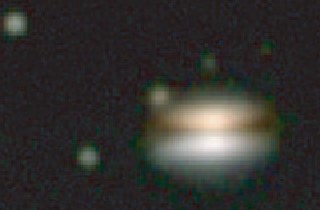News
The shadow of the Flying Saucer: A very low temperature for large dust grains.
ALMA and IRAM-30m observations of carbon monoxide (CO) were used to determine a very low temperature of large dust grains in the disk around a young star in the Ophiuchus star forming region. These
observations were conducted by an international team, led by a scientist at the Laboratoire d'Astrophysique de Bordeaux.
The young star is surrounded by a disk of gas and dust, called protoplanetary disk as such disks are progenitors of planetary systems. This disk is seen nearly edge-on, and at visible wavelengths only the stellar light scattered by small dust grains in the disk is visible (see Figure). Because of its aspect, the object has been nicknamed the "Flying Saucer".
 |
| Infrared Image of the proto-planetary disk ; credit : ESO (Grosso et al.) |
The astronomers observed CO emission with ALMA to map the disk properties at high spatial resolution (0.5"). They were surprised to detect at some velocities a negative signal indicative of absorption.
This phenomenon is due to a temperature difference between the dust grains in the disk, and an extended molecular gas cloud situated behind the Flying Saucer.
The ALMA interferometer measures only spatial variations in the signal intensity filtering out the emission of the extended and uniform background cloud, except in the direction of the disk, where the dust absorbs the emission from CO molecules and appears in silhouette as a negative signal. The Earth is thus in the
shadow of the "Flying Saucer" with respect to the bright CO cloud.
By comparing the intensity of the absorbed signal to that of the thermal dust emission in the protoplanetary disk, the team could directly measure the ratio between the dust temperature and that of the CO background gas, the latter measured with the IRAM 30-m telescope. The team derived a dust temperature of only 7K at 100 astronomical units from the central star. This is the first direct measurement of the temperature of large grains (size about one mm) in such objects. A temperature of only 7K is very low compared to most models, which predict 15 to 20K. To allow the large dust grains to cool down to such low temperatures, they must have different properties than currently assumed.
Contacts:
LAB : S. Guilloteau, E. di Folco (guilloteau@obs.u-bordeaux1.fr, difolco@obs.u-bordeaux1.fr)
IRAM : V.Pietu (pietu@iram.fr)
Laboratories:
LAB, CNRS/Université de Bordeaux
IRAM, Grenoble
Observatoire Astronomique de Strasbourg
Max Planck Institute fur Astronomie, Heidelberg
Références:
Guilloteau et al "The shadow of the Flying Saucer: a very low temperature for large dust grains", Astronomy & Astrophysics Letters, (Received: 23 October 2015 / Accepted: 21 December 2015).
http://www.insu.cnrs.fr/node/5603
Public Relations Contact
Karin Zacher
IRAM Public Relations Officer
Tel : +33 4 76 82 21 03
Mail : zacher@iram.fr

